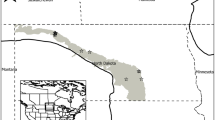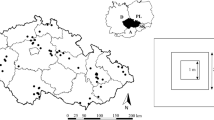Abstract
Coastal marshes are composed of distinct vegetation assemblages that contribute to ecosystem functions and services over time and space. In recent decades, natural and anthropogenic changes have led to large-scale marsh loss along the Chenier Plain of the Gulf of Mexico. An understanding of the composition and dominance of the vegetation assemblages that form these coastal marshes is necessary to effectively assess and monitor their stability under changing conditions. To investigate marsh vegetation assemblages along the Texas Chenier Plain, we analyzed the composition and dominance of 135 marsh plots distributed across two study areas bordering the East Bay of Galveston Bay in Chambers County, Texas using cluster analysis. Seven general vegetation assemblages were identified. The assemblages were evaluated using indicator species analysis and Multi-Response Permutation Procedures and compared to marsh vegetation assemblages found in the Louisiana Chenier Plain. Our data provide a foundation for better understanding of vegetation patterns found along the East Texas Chenier Plain allowing managers and conservationists the ability to better evaluate the effects of marsh change due to climatic and human driven pressures.

Similar content being viewed by others
References
Abella SR, Prengaman KA, Embrey TM, Schmid SM, Newton AC, Merkler DJ (2012) A hierarchical analysis of vegetation on a Mojave Desert landscape, USA. J Arid Environ 78:135–143
Adam P (1990) Saltmarsh ecology. Cambridge University Press, Cambridge
Augustinus PGEF (1989) Cheniers and chenier plains: a general introduction. Mar Geol 90:219–229
Barbier EB (2011) Progress and challenges in valuing coastal and marine ecosystem services. Rev Environ Econ Policy 6:1–19
Bertness MD (1991a) Interspecific interactions among high marsh perennials in a New England salt marsh. Ecology 72:125–137
Bertness MD (1991b) Zonation of Spartina patens and Spartina alterniflora in New England salt marsh. Ecology 72:138–148
Brewer JS, Grace JB (1990) Plant community structure in an oligohaline tidal marsh. Vegetatio 90:93–107
Broome SW, Mendelssohn IA, Mckee KL (1995) Relative growth of Spartina patens (Ait.) Muhl. and Scirpus olneyi gray occuring in a mixed stand as affected by salinity and flooding depth. Wetlands 15:20–30
Cahoon DR (2006) A review of major storm impacts on coastal wetland elevations. Estuar Coasts 29:889–898
Cahoon DR, Hensel PF, Spencer T, Reed DJ, McKee KL, Saintilan N (2006) Coastal wetland vulnerability to relative sea-level rise: wetland elevation trends and process controls. In: Verhoeven JTA, Beltman B, Bobbink R, Whigham DF (eds) Wetlands and natural resource management. Springer, Berlin, pp 271–292
Casanova MT, Brock MA (2000) How do depth, duration and frequency of flooding influence the establishment of wetland plant communities? Plant Ecol 147:237–250
Census Bureau (2010) Census of population, public law 94–171. US Census Bureau, Washington
Chabreck RH (1972) Vegetation, water, and soil characteristics of the Louisiana coastal region. Baton Rouge, LA
Chabreck RH, Joanen T, Paulus SL (1989) Southern coastal marshes and lakes. In: Smith LM, Pederson RL, Kaminski RM (eds) Habitat management for migrating and wintering waterfowl in North America. Texas Tech University Press, Lubbock
Costanza R, D’Agrosa C, de Groot R, Farber S, Grasso M, Hannon B, Limburg K, Naeem S, O’Neill RV, Paruelo J, Raskin RG, Sutton P, van den Belt M (1997) The value of the world’s ecosystem services and natural capital. Nature 387:253–260
CPRA (2012) Louisiana’s comprehensive master plan for a sustainable coast. CRPA Baton Rouge, LA
Crout JD (1976) Soil survey of Chambers County, Texas
Day JW, Christian RR, Boesch DF, Yanez-Arancibia A, Morris JT, Twilley RR, Naylor LA, Schaffner L, Stevenson C (2008) Consequences of climate change on the ecogeomorphology of coastal wetlands. Estuar Coasts 31:477–491
Deegan LA, Johnson DS, Warren RS, Peterson BJ, Fleeger JW, Fagherazzi S, Wolheim WM (2012) Coastal eutrophication as a driver of salt marsh loss. Nature 490:388–392
Donnelly JP, Bertness MD (2001) Rapid shoreward encroachment of salt marsh cordgrass in response to accelerated sea-level rise. Proc Natl Acad Sci U S A 98:14218–14223
Ehrlich PR, Ehrlich A (1981) Extinction: the causes and consequences of the disappearance of species. Random House, New York
Emery NC, Ewanchuk PJ, Bertness MD (2001) Competition and salt-marsh plant zonation: stress tolerators may be dominant competitors. Ecology 82:2471–2485
Feagin RA, Martinez ML, Mendoza-Gonzalez G, Costanza R (2010) Salt marsh zonal migration and ecosystem service change in response to global sea level rise: a case study from an urban region. Ecol Soc 15:14
FitzGerald DM, Fenster MS, Argow BA, Buynevich IV (2008) Coastal impacts due to sea-level rise. Ann Rev Earth Planet Sci 36:601–647
Gabrey SW, Afton AD (2001) Plant community composition and biomass in Gulf Coast Chenier Plain marshes: responses to winter burning and structural marsh management. Environ Manag 27:281–293
Gauch HG, Whittaker RH (1981) Hierarchical classification of community data. J Ecol 69:537–557
Gedan KB, Silliman BR, Bertness MD (2009) Centuries of human-driven change in salt marsh ecosystems. Ann Rev Mar Sci 1:117–141
Godfrey RK, Wooten JW (1981a) Aquatic and wetland plants of southeastern united states dicotyledons. University of Georgia Press, Athens
Godfrey RK, Wooten JW (1981b) Aquatic and wetland plants of southeastern united states monocotyledons. University of Georgia Press, Athens
Gosselink JG (1978) An ecological characterization study of the Chenier Plain coastal ecosystem of Louisiana and Texas. Slidell FWS/OBS-78/9–78/11
Hickey D, Bruce E (2010) Examining tidal inundation and salt marsh vegetation distribution patterns using spatial analysis (Botany Bay, Australia). J Coast Res 26:94–102
ITT (2009) ITT visual information solutions; environment for visualizing images. Boulder, CO
Johnson JS (2011) Changing vegetation dynamics of a coastal salt marsh: Galveston Bay, Texas. Thesis Texas A&M University, College Station
Johnson WB, Sasser CE, Gosselink JG (1985) Succession of vegetation in an evolving river delta, Atchafalaya Bay, Louisiana. J Ecol 73:973
Kennish MJ (2001) Coastal salt marsh systems in the U.S.: a review of anthropogenic impacts. J Coast Res 17:731–748
Kim D, Cairns DM, Bartholdy J (2010) Environmental controls on multiscale spatial patterns of salt marsh vegetation. Phys Geogr 31:58–78
Kim D, Cairns DM, Bartholdy J (2011) Wind-driven sea-level variation influences dynamics of salt marsh vegetation. Ann Assoc Am Geogr 101:231–248
Kirwan ML, Guntenspergen GR, Morris JT (2009) Latitudinal trends in Spartina alterniflora productivity and the response of coastal marshes to global change. Glob Chang Biol 15:1982–1989
Koch EW, Barbier EB, Silliman BR, Reed DJ, Perillo GME, Hacker SD, Granek EF, Primavera JH, Muthiga N, Polasky S, Halpern BS, Kennedy CJ, Kappel CV, Wolanski E (2009) Non-linearity in ecosystem services: temporal and spatial variability in coastal protection. Front Ecol Environ 7:29–37
Kunza AE, Pennings SC (2008) Patterns of plant diversity in Georgia and Texas salt marshes. Estuar Coasts 31:673–681
Lausi D, Feoli E (1979) Hierarchical classification of European salt marsh vegetation based on numerical methods. Vegetatio 39:171–184
Lester J (2002) The state of the bay: a characterization of the Glaveston Bay ecosystem. 2nd edition. Galveston Bay National Estuary Program, Webster
Li C, Roberts HH, Stone GW, Weeks E, Luo Y (2011) Wind surge and saltwater intrusion in Atchafalaya Bay during onshore winds prior to cold front passage. Hydrobiologia 658:27–39
Little AM, Guntenspergen GR, Allen FH (2010) Conceptual hierarchical modeling to describe wetland plant community organization. Wetlands 30:55–65
McCune B, Grace J (2002) Analysis of ecological communities. Mjm Software Design
McCune B, Mefford MJ (1999) PC-ORD for Windows, multivariate analysis of ecological data. MjM Software, Gleneden Beach
MEA (2005) Ecosystems and human well-being: current state and trends, volume 1. Island Press, Washington
Mitsch WJ, Gosselink JG (2000) Wetlands, 3rd edn. John Wiley and Sons, New York
Morton RA, Bernier JC, Barras JA (2006) Evidence of regional subsidence and associated interior wetland loss induced by hydrocarbon production, Gulf Coast region, USA. Environ Geol 50:261–274
Nicholls R, Wong PP, Burkett VR, Codignotto JO, Hay JE, McLean RF, Ragoonaden S, Woodroffe CD (2007) Coastal systems and low-lying areas. Climate change 2007: impacts, adaptations and vulnerability. In: Parry ML, Canziani OF, Palutikof JP, van der Linden PJ, Hanson CE (eds) Contirbution of working group II to the fourth assessment report of the Intergovernmental Panel on Climate Change. Cambridge University Press, Cambridge
Parris A, Bromirski V, Burkett VR, Cayan D, Culver M, Hall JW, Horton R, Knuutri K, Moss R, Obeysekera J, Sallenger A, Weiss J (2012) Global sea level rise scenarios for the US National Climate Assessment. NOAA Tech Memo. OAR CPO-1
Peterson MJ, Hall DM, Feldpausch-Parker AM, Peterson TR (2010) Obscuring ecosystem function with application of the ecosystem services concept. Conserv Biol 24:113–119
Ravens TM, Thomas RC, Roberts KA, Santschi PH (2009) Causes of salt marsh erosion in Galveston Bay, Texas. J Coast Res 25:265–272
Redfield AC (1972) Development of a New England salt marsh. Ecol Monogr 42:201–237
Reed DJ (1995) The response of coastal marshes to sea-level rise: survival or submergence? Surf Process Landf 20:39–48
Silvestri S, Defina A, Marani M (2005) Tidal regime, salinity and salt marsh plant zonation. Estuarine Coastal Shelf Sci 62:119–130
Stutzenbaker CD (1999) Aquatic and wetland plants of the western Gulf Coast. Texas Parks and Wildlife, Austin
Teal JM, Kanwisher JW (1966) Gas transport in the marsh grass, Spartina alterniflora. J Exp Bot 17:355–361
Visser JM, Sasser CE, Chabreck RH, Linscombe R (1999) Long-term vegetation change in Louisiana tidal marshes, 1968–1992. Wetlands 19:168–175
Visser JM, Sasser CE, Linscombe RG, Chabreck RH (2000) Marsh vegetation types of the Chenier Plain, Louisiana, USA. Estuaries 23:318–327
Visser JM, Duke-Sylvester S, Broussard W, Carter J (2012) LAVegMod: Louisiana’s comprehensive master plan for a sustainable coast. Coastal Protection and Restoration Authority of Louisiana. Baton Rouge, LA
Walker HJ (2005) Ice-bordered coasts. In: Schwartz ML (ed) Encyclopedia of coastal science. Springer, Netherlands, pp 542–545
White WA, Tremblay TA (1995) Submergence of wetlands as a result of human-induced subsidence and faulting along the upper Texas Gulf-Coast. J Coast Res 11:788–807
White WA, Calnan TR, Morton RA, Kimble RS, Littleton TG, McGowen JH, Nance HS, Schmedes KE (1985) Submerged lands of Texas Galveston-Houston area: sediments, geochemistry, benthic macroinvertebrates, and associated wetlands. Bureau of Economic Geology, Austin
White WA, Morton RA, Holmes CW (2002) A comparison of factors controlling sedimentation rates and wetland loss in fluvial-deltaic systems, Texas gulf coast. Geomorphology 44:47–66
Wilkins N, Brown RD, Conner RJ, Engle J, Gilliland C, Hays A, Slack RD, Steinbach DW (2000) Fragmented lands: changing land ownership in Texas. Texas A&M Agriculture Program
Yoskowitz D, Carollo C, Beseres-Pollack J, Welder K, Santos C, Francis J (2012) Assessment of changing ecosystem services provided by marsh habitat in the Galveston Bay region. p. 75. Harte Research Institute
Acknowledgments
This research was funded through a Texas Sea Grant Minigrant to DC and CH. We would like to thank Eddie Gray and Bill Gammell for sharing their local knowledge and providing valuable insight into the East Bay marshes. We would like to thank Leroy Ezer for providing us access to the Canada Ranch. We are also grateful to Patrick Walther and the USFWS for providing us access and assistance at Anahuac NWR. We gratefully acknowledge two anonymous reviewers for providing constructive comments on an earlier version of this paper.
Author information
Authors and Affiliations
Corresponding author
Rights and permissions
About this article
Cite this article
Johnson, J.S., Cairns, D.M. & Houser, C. Coastal Marsh Vegetation Assemblages of Galveston Bay: Insights for the East Texas Chenier Plain. Wetlands 33, 861–870 (2013). https://doi.org/10.1007/s13157-013-0443-8
Received:
Accepted:
Published:
Issue Date:
DOI: https://doi.org/10.1007/s13157-013-0443-8




